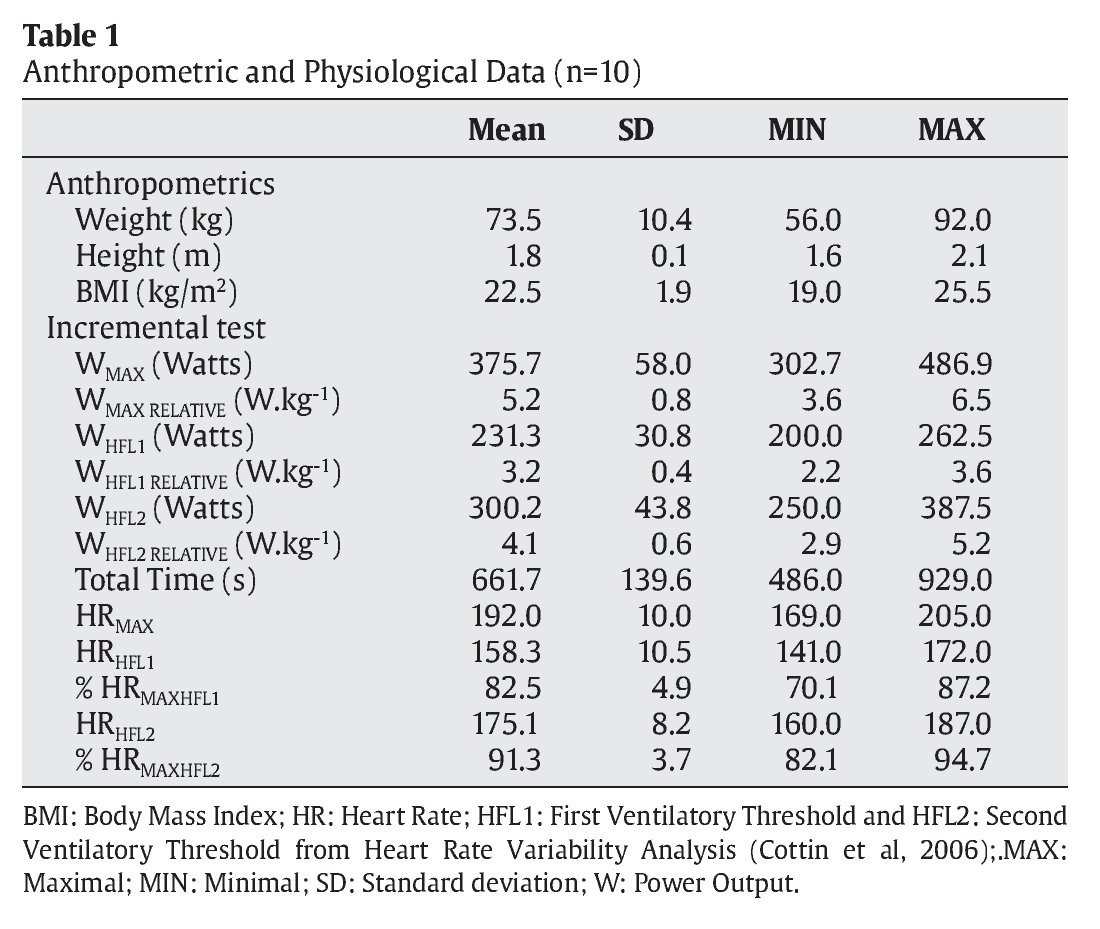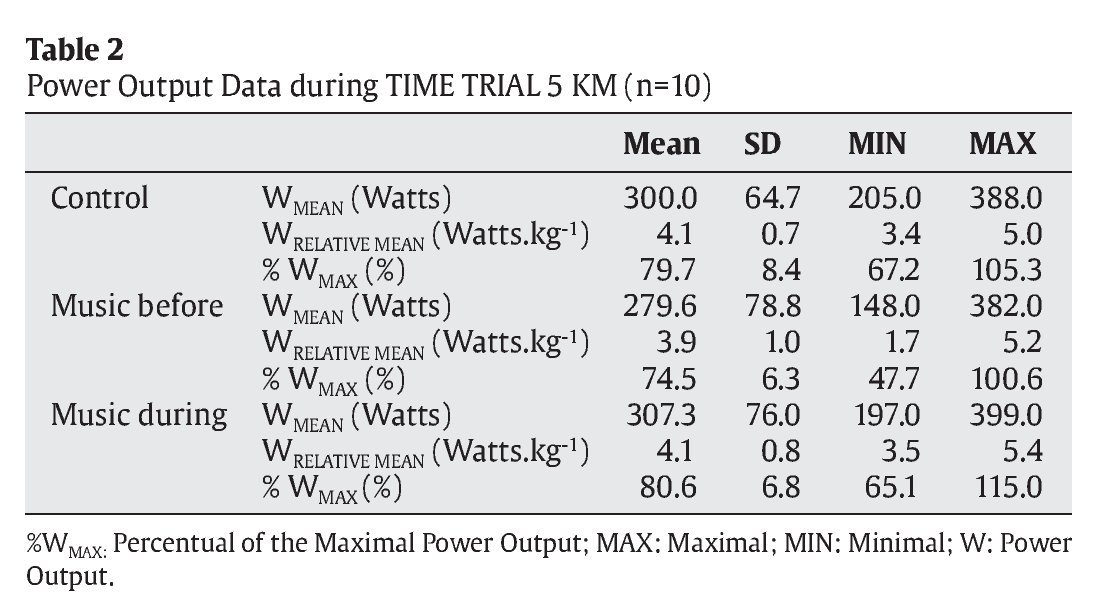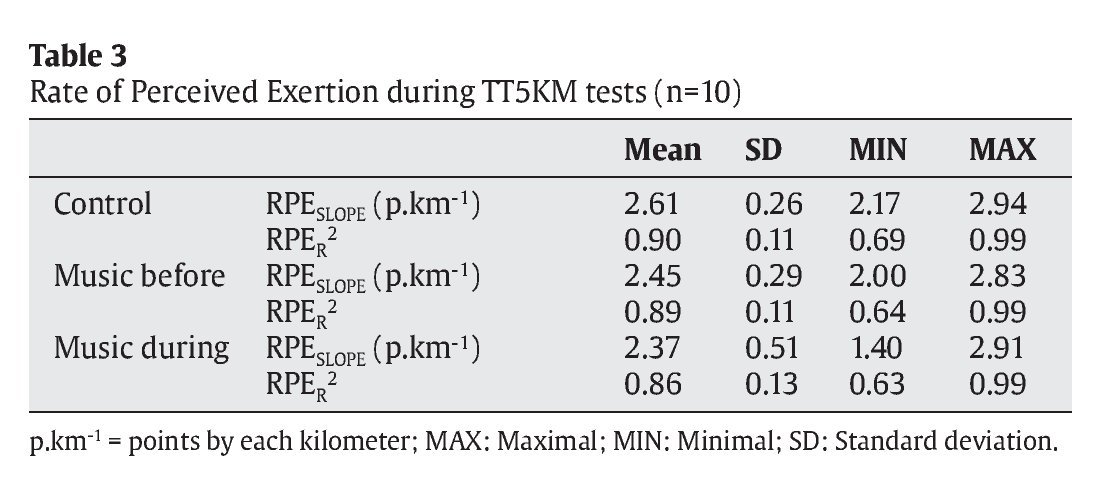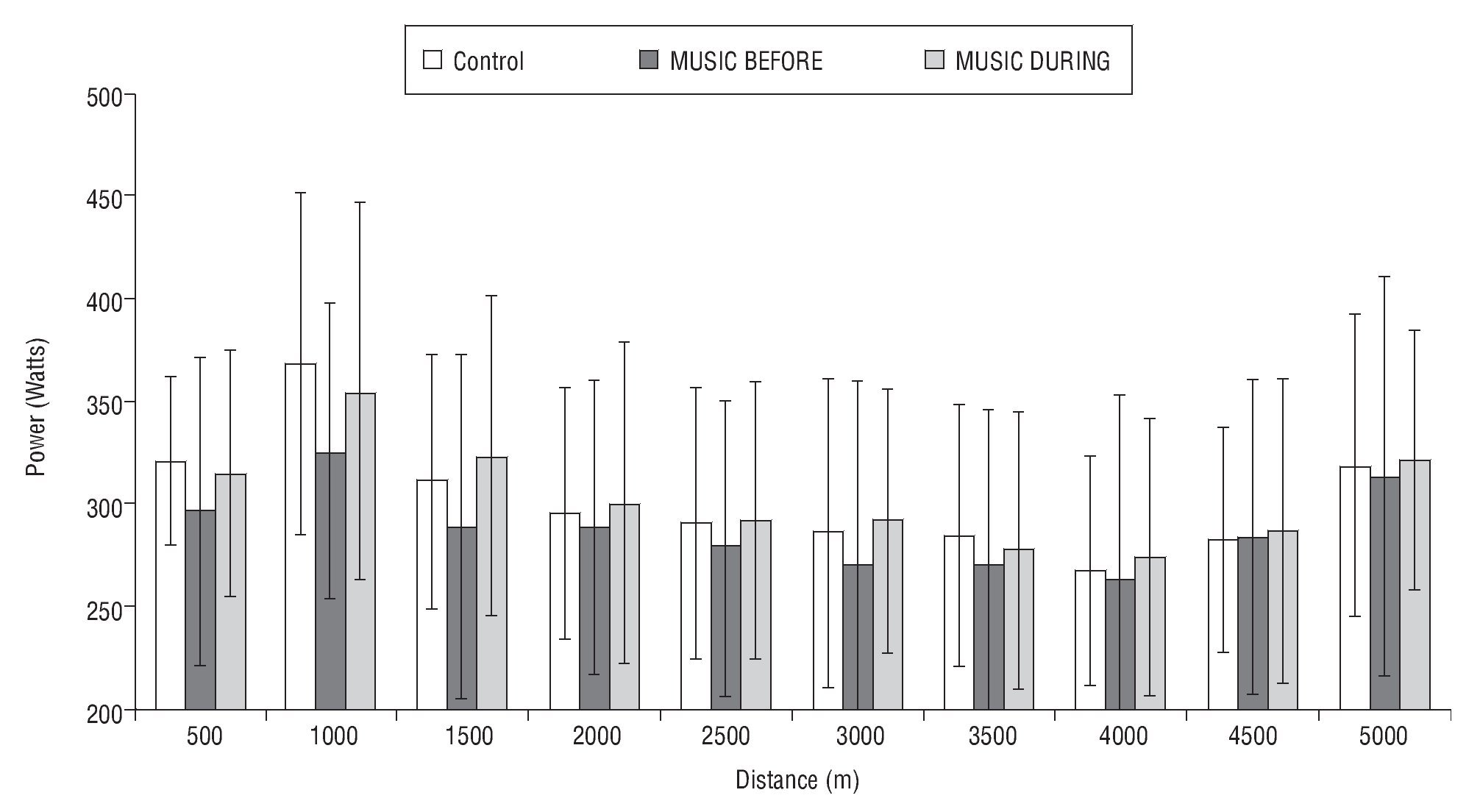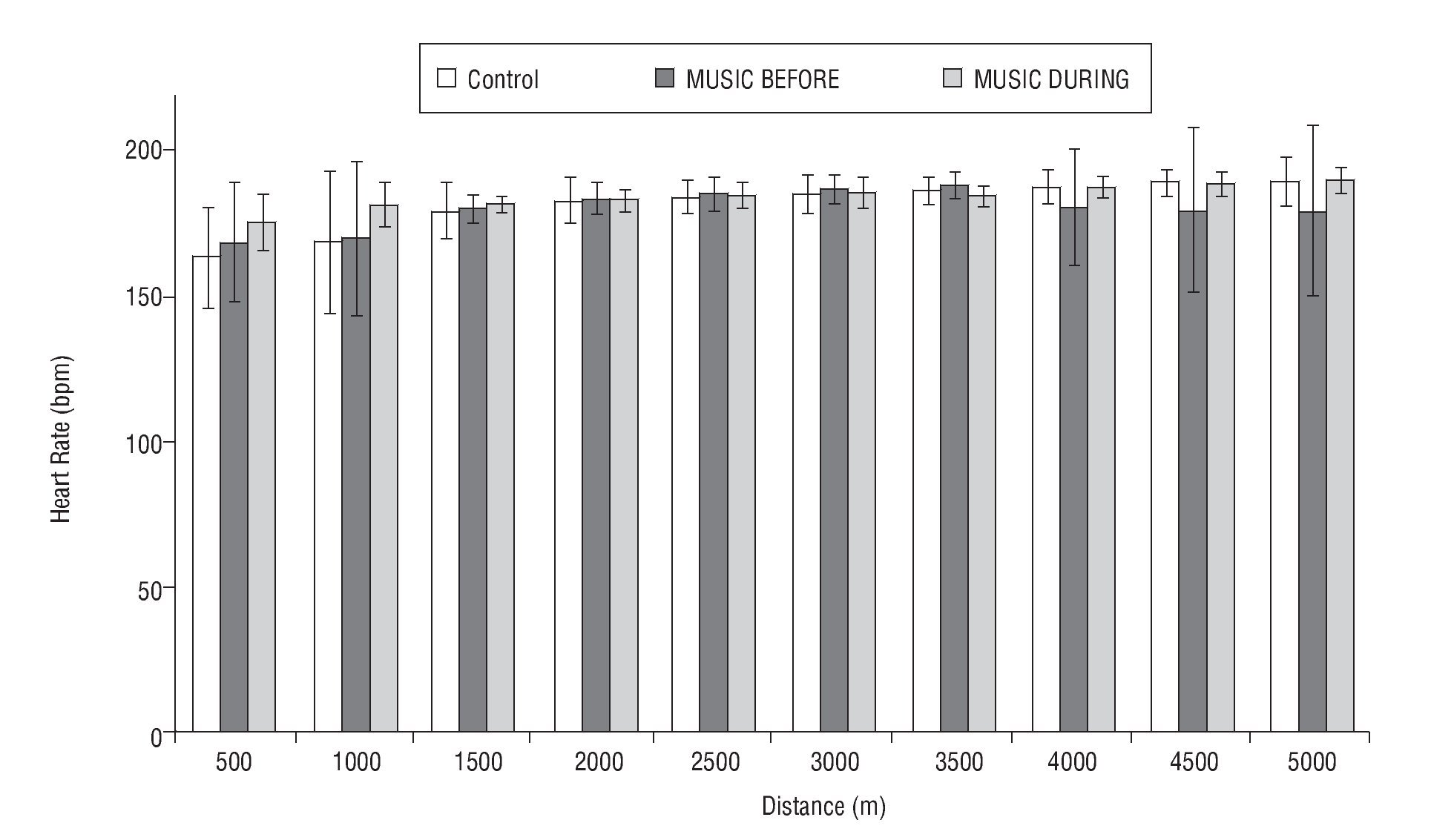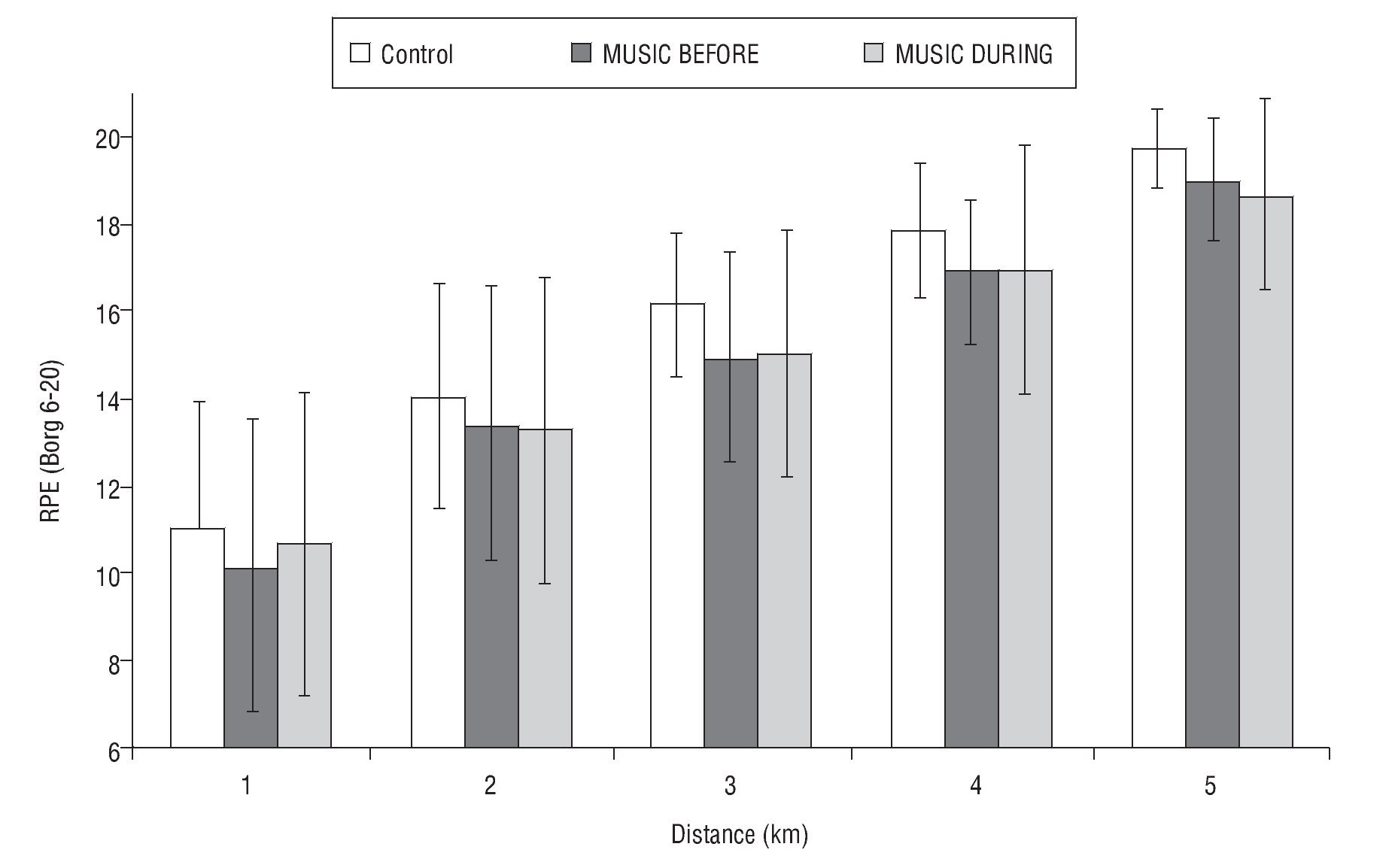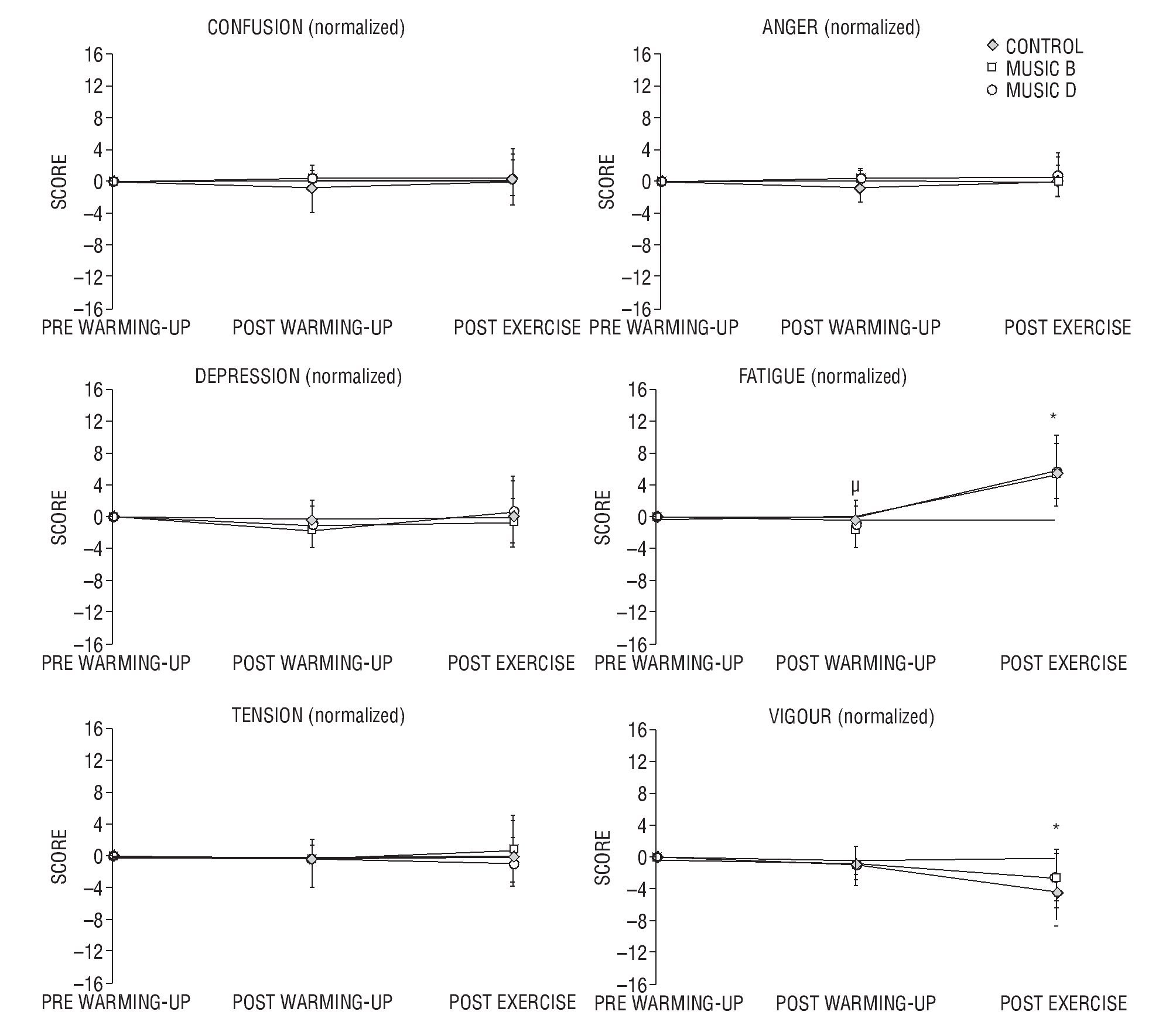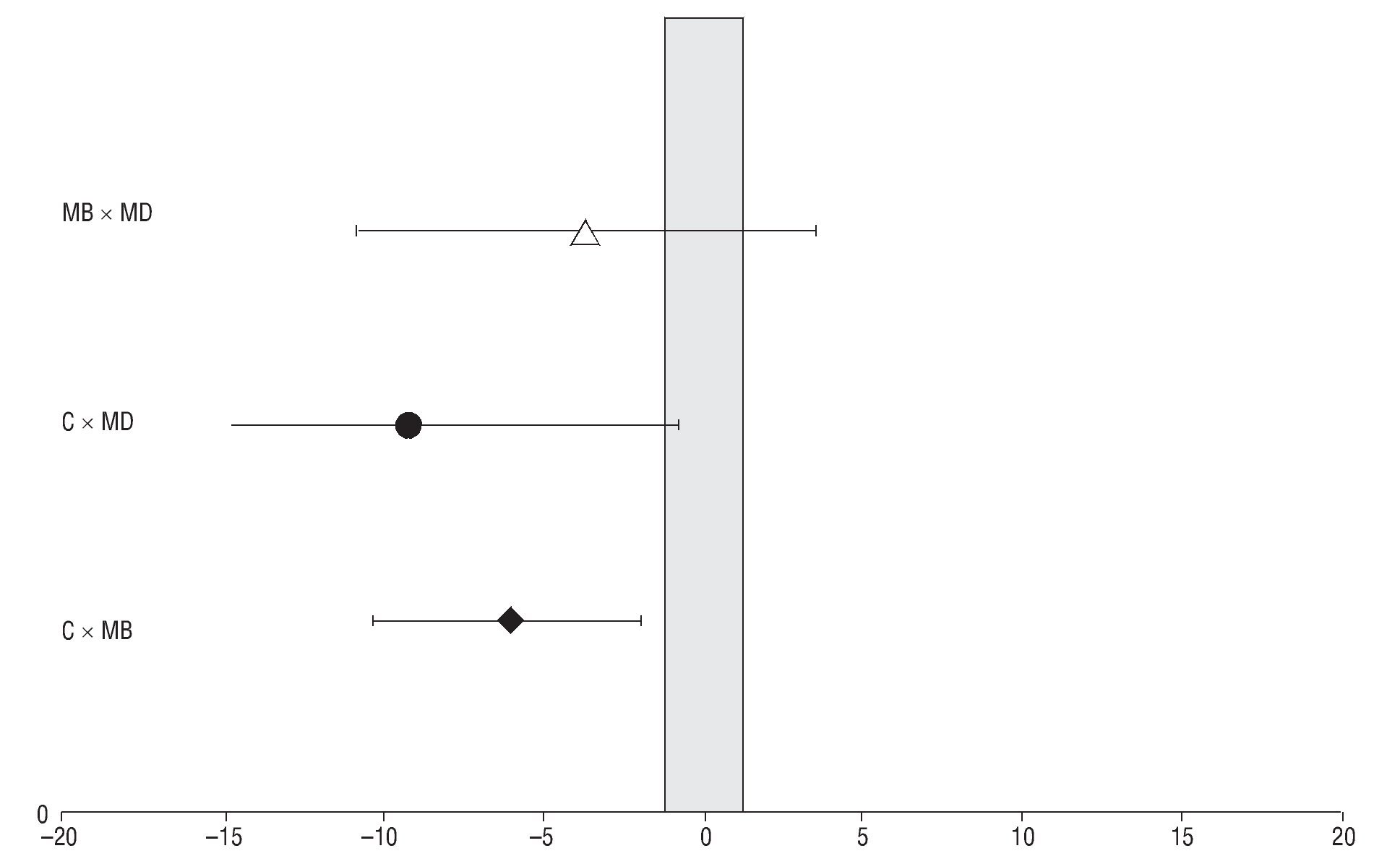Objective. The purpose of this study was to verify the influence of music introduced in different moments in a 5-km time-trial cycling (TT5KM) on psychophysical variables.
Methods. Ten trained cyclists participated in this study (24 ± 1 years; 73.5 ± 10.4 kg; 180 ± 12 cm). The participants performed the TT5KM in three distinct conditions: music during warm-up (MW), music during the protocol (MP) and control (C). During all conditions the time (T), power output (W), heart rate (HR) and rating of perceived exertion (RPE) was evaluated and the mood state was assessed with the BRUMS questionnaire. After descriptive statistics, data normality was confirmed using the Shapiro-Wilk's test. Mean performance, performance at each 500m, RPE at each 1000m and mood state were compared with ANOVA two way for repeated measures (moment x condition). The significance level was set at p<0.05. A parallel statistic was used to find the smallest worthwhile change of all variables to verify the possibility of the effect to be trivial, beneficial or prejudicial.
Results. None of the variables showed any difference between groups (p>0.05), but there is a possibility of RPE to be smaller when the subject listen music during (90%) or before (93%) the test compared with control condition.
Conclusion. Our results showed that regardless the time of application (i.e., before or during exercise), music did not affect performance and psychophysiological parameters during the TT5KM.
Objetivo. El propósito de este estudio fue verificar la influencia de la música introducida en diferentes momentos en una contrarreloj de ciclismo de 5 km sobre las variables psicofisiológicas.
Método. Diez ciclistas entrenados participaron en este estudio (24 ± 1 años; 73,5 ± 10,4 kg, 180 ± 12 cm). Los participantes realizaron la contrarreloj de ciclismo de 5 km en 3 condiciones diferentes: música durante el precalentamiento, música durante el protocolo y control. Durante todas las condiciones fue evaluado el tiempo, la potencia, la frecuencia cardíaca y la percepción subjetiva de esfuerzo, y el estado de humor fue evaluado con el cuestionario BRUMS. Después de la estadística descriptiva, la normalidad de los datos fue confirmada por el test de Shapiro-Wilk. La media de rendimiento, el rendimiento a cada 500 m, percepción subjetiva de esfuerzo a cada 1.000 m y el estado de humor fueron comparados con la ANOVA de 2 factores para medidas repetidas (momento x condición). El nivel de significancia fue fijado en p < 0,05. Una estadística paralela fue utilizada para encontrar la menor variación de valor de todas las variables y de esta forma verificar la posibilidad de que el efecto sea trivial, benéfico o perjudicial.
Resultados. Ninguna de las variables presentó diferencia entre los grupos (p > 0,05), pero existe una posibilidad de que su percepción subjetiva de esfuerzo sea pequeña cuando el individuo escucha música durante (90%) o antes (93%) del test en comparación con el test de condición de control.
Conclusiones. Nuestros resultados mostraron que con independencia del momento de aplicación (por ejemplo, antes o durante el ejercicio), la música no afectó al rendimiento y las variables psicofisiológicas durante una contrarreloj de ciclismo de 5 km.
Introduction
During competitive individual events, a very small enhancement of performance by an athlete may be decisive for the event's outcome1. In many sports, performance is defined primarily by the mechanisms responsible for fatigue throughout the event. Often the outcome of the event depends on small changes of such mechanisms2. In order to improve performance, several ergogenic aids have been used by athletes, such as nutritional, pharmacological, biomechanical, physiological and psychological aids3. Psychological aids, despite other effects, can be understood as interventions that are capable to increase the motivational aspect of an athlete before or during competition. Examples include the use of verbal encouragement, pictures, videos and music4.
Motivation may improve motor performance through a general arousing or energizing effect5, independent of their arousal source to the task. The arousal (energy dispended) directed to a sense, is based on construct that could be explained by goal orientation (allowing a task be finished with maximal ability)6. It has been shown that subjects, after seeing highly arousing pictures, produced more force and reported lower effort sensation7. In this way music has been shown capable of enhancing motivation and arousal for sports8, leading to significant changes in psychophysiological factors such as reduced tiredness and augmented pleasure9 (lower blood lactate and catecholamines concentrations10, and increased time to exhaustion or distanced covered in certain tasks11-13. Mood states is a very important factor to be monitored in sports domain, once it is capable to change physiological variables and as consequence, alter performance, also it is a very complicated factor to control, once that it is changed by many aspects during the personal life of the athlete, therefore, music can act in some moods domain turning to better some psychoaffective characteristics14.
Several studies have investigated the effects of music on performance in both submaximal9,15-17 and maximal exercises13,18. However, few studies have attempted to study the effects of music during warm-up, leading to controversial results. Yamamoto and colleagues21 found that listening to two different types of music during warm-up had no effect on mean power output in a subsequent supramaximal exercise lasting 45s. On the other hand, Eliakim and colleagues22 reported an increased peak of anaerobic power in volleyball players during a Wingate Anaerobic Test (30s) after listening to arousal music during warm-up. Still, little is known whether listening to music only during warm-up or during exercise can enhance following performance during a more real condition of competition such as a time-trial with medium duration. As it is common practice among athletes to listen to music before competition aiming to increase their motivation, scientific-based information is required to support this practice.
Therefore, the aims of this study were to verify the effects of music on performance and psychophysiological parameters during a 5km cycling time trial in two different moments of application, (1) before (warm-up) and (2) during the trial. It is hypothesized that during both situations music will reduce perception of effort and increase motivation, leading to increased performance.
Methods
Subjects
The sample size was calculated using total time as the main variable from Atkinson et al. study23, once presented similar task and kind of population, assuming significance value: 0.05, statistical power: 0.80, ratio = 1, mean of differences between two experimental conditions, and standard deviation from experimental protocol, but we could not attempt this number of professional cyclists. Therefore, ten cyclists (24 ± 1 years; 73.5 ± 10.4 kg; 180 ± 12 cm) participated of this study. All cyclists were competing in regional and national levels and the data obtained during their incremental tests (Wmax = 375.7 ± 58.0 W; W aerobic threshold = 231.3 ± 30.8 W; W anaerobic threshold = 300.2 ± 43.8 W) classified them among amateur and professional athletes according to the literature24,25. Subjects were instructed to refrain from vigorous activities and ingestion of caffeine or alcohol-containing substances 24 hours prior the experiments. All tests were performed at the same time of day (± 1 h) to avoid the circadian variation. This study was approved by the local Institutional Research Ethics Committee.
Study design
All subjects performed the four test sessions on an electronically braked cycle ergometer (VelotronTM, Dynafit Model, Racer Mate®, USA) consisting of a maximal incremental test (MIT) and three 5-km time trials (TT5KM).
Maximal incremental test
The MIT was used to obtain the maximal power output (WMAX), maximal heart rate (HRMAX), and physiological thresholds from the athletes. Biomechanical adjustments (seat and handle bar height and distance) were made for all subjects according to the literature26,27. All adjustments were recorded in the first session and reproduced in the subsequent tests.
Each MIT started at 25W, with increments of 25 W.min-1 until voluntary exhaustion or until subjects could no longer maintain a pedaling rate of 70 rpm for 5 seconds. WMAX was considered the power output in the final completed stage added to the product of the percentage time spent in the final, not completed, stage with the power increment (25 W)28. HRMAX was considered the highest HR value found during the last minute of the test. With the HR variability (HRV) data obtained during MIT, the HRV thresholds were calculated using the product of the frequency and the power of the high frequency component. This method allows the calculation of the HFt1 and HFt2 thresholds, which corresponds to the first ventilatory threshold (aerobic) and the respiratory compensation point (anaerobic)29.
Time-trial 5 KM
The TT5KM consisted of a task to be completed as fast as possible, with free cadence and gear choice. The TT5KM was performed in the control condition (CON), music during warm-up (MW) and music during the protocol (MP). Subjects received feedback regarding distance covered throughout the TT5KM via a computer monitor. Previously to each TT5KM, subjects performed a warm-up protocol consisting of 10 minutes of exercise, distributed in one set of four minutes at the power output corresponding to 55% of WMAX and other two sets of three minutes at 60 and 65% of WMAX, respectively, and followed by two minutes of rest before TT5KM. This warm-up protocol was adapted from Hajoglou et al32. During all TT5KM the variables mean power output (MPO), mean speed (MS), HRMAX percentage (%HRMAX), ratings of perceived exertion (RPE) and total time (TT) were monitored. Partial mean power output was monitored by an average of each 500m and RPE at each 1000m during the test.
All three conditions (CON, MW and MP) were randomized, and music was previously chosen by subjects, once it has been demonstrated the positive effects of preferred music on performance11. During the first test session (MIT) volunteers were instructed to bring motivational music to the next tests (TT5KM). The music brought by each athlete was recorded into a MP3 player (Sony® Electronics Inc. - Sony Corporation of America - USA), and transmitted through earphones to subjects. Subjects were instructed to choose music capable of increase motivation to complete the time-trial as soon as possible. Music should be chosen according to their preferences for training and/or competition routines, and volume followed the same recommendation.
Assessment of mood states
During the TT5KM session subjects were asked to answer to the Brunel Mood Scale (BRUMS) before warm-up, after warm-up and right after the TT5KM. This tool represents a questionnaire to assess mood states, consisting of 24 questions stratified into six mood domains: Anger, Confusion, Depression, Fatigue, Tension and Vigour33. Each domain score was normalized by the score obtained before warm-up. Then the score variation of each domain was determined by subtracting the score obtained in each moment of application in relation to the pre warming-up value, as shown in the formula below:
Variation = moment - pre warming-up value
Moment = post warming-up or post exercise moments values.
Consequently, after normalization all subjects started with a null value, which means, a score of zero. Hence, the differences between initial values among subjects were eliminated and only the variation caused by exercise on mood states was assessed. This questionnaire was choose for been a shorter version of POMS and more adequate to use with athletes due their characteristics and shorter time to answer34.
Ratings of perceived exertion
Each minute during MIT and at each kilometer during TT5KM, subjects were instructed to report their ratings of perceived exertion (RPE) according to the 15 points scale (6-20), answering the following question: "how hard is the task at this moment?"35,36. For all tests the values very, very light (7) and very, very hard (19) were used as anchoring points37. There was also the instruction regarding the importance of the veracity about the reported RPE, highlighting the fact that answering a lower or higher value to that real perceived would not influence on performance evaluation.
Data analysis
After descriptive statistics, data normality was confirmed using the Shapiro-Wilk's test. Mean performance, performance at each 500m and RPE at each 1000m were compared with ANOVA two way for repeated measures (moment x condition), employing the Greenhouse-Geisser correction when necessary. After normalization of BRUMS' domains variation, the same procedure was used. The significance level was set at P<0.05. A parallel statistic was used to find the smallest worthwhile change of all variables to verify the possibility of the effect to be trivial, beneficial or prejudicial. The chances exist in test was classified in < 1% almost sure that not; 1% to 5% very unlikely; 5% to 25% unlikely; 25% to 75% possible; 75% to 95% likely; 95% to 99% very likely; > 99% almost sure. If the chance of beneficial effect and the decrease in performance were both higher than 5%, the classification was considered undetermined38.
Results
Subjects' physiological characteristics are shown in table 1.
Mean speed in the TT5KM did not show significant difference between conditions (n=10; CON = 38.1 (3.3) km.h-1; MW = 36.9 (4.8) km.h-1; MP = 38.6 (3.7) km.h-1; F= 0.776; P= 0.411). Consequently the mean power output (F= 0.872; P= 0.387) (table 2) and total time (CON = 476.4 (39.3) s; MW = 498.1 (70.9) s; MP = 472.5 (43.2) s; F= 0.960; P= 0.357) also did not show significant difference. There was also no significant difference to the power output at each 500m throughout the time trial between experimental conditions at any distance (F= 0.520; P= 0.773) (fig. 1).
Fig. 1. Outcome of the power output during the 5-km time trial (mean [bars] ± SD [error bars]), n=10.
In relation to %HRMAX, no significant difference was observed between conditions (CON = 93.5 (3.7) %HRMAX; MW = 93.5 (3.1) %HRMAX; MP = 95.5 (2.0) %HRMAX; F= 1.0; P= 0.402). The %HRMAX at each 500m also did not show statistical differences between experimental conditions (F= 0.744; P= 0.761) (fig. 2).
Fig. 2. Outcome of the heart rate during the 5-km time trial (mean [bars] ± SD [error bars]), n=10.
RPE increased significantly as distance cycled increased (F= 151.72; P< 0.001, R2= 0.849) (fig. 3). However, similarly to the behavior of mean power output (fig. 1), RPE throughout TT5KM did not show significant difference between conditions (F= 0.264; P= 0.866) (fig. 3). In the same way, no statistical difference was found to the rate of increase (SLOPE) (F= 2.833; P= 0.113) and explanation coefficient (R2) (F= 0.823; P= 0.404) of RPE (table 3).
Fig. 3. Rate of perceived exertion during the 5-km time trial (mean [bars], ± SD [error bars]), n=10.
Most of the BRUMS domains did not show significant differences between moments and conditions (P> 0.05) (fig. 4). Only the domains of fatigue (F= 48.473; P< 0.001) and vigor (F= 16.976; P< 0.001) were significantly altered by the exercise effects, but without statistical difference between experimental conditions (condition vs. moment factor: F= 0.044; P= 0.974 for fatigue; F= 0.628; P= 0.590 for vigor). Figure 5 shows that there is 93% in chance to music decrease the slope of perceived exertion if heard before the test, being considered likely to effect when compared with the control condition (MB x C) and 90% when comparing the conditions music during with control (MD x C). When comparing the situations music before and music during (MB x MD), the possibility was found to be trivial, and considered undetermined. Every other variables were also considered undetermined when analyzed by smallest worthwhile change.
Fig. 4. Change of the BRUMS' subscales in the pre warming-up, post warming-up and post exercise moments. 1significant difference in relation to pre warming-up in all conditions (p < 0,05); * significant difference in relation to pre and post warming-up in all conditions (p < 0,01).
Fig. 5. The Smallest Worthwhile Change to slope of rate of perceived exertion between three conditions: C x MB (0/6/93), C x MD (3/8/90) and MB x MD (10/37/53), n=10.
Discussion
The main findings of the present study showed that the presence of music had no effects on performance and psychophysiological parameters regardless of the moment of its application (before or during TT5KM). These results were found both to the mean values as well as throughout the TT5KM. Our findings do not support the belief of athletes that listening to music before the competition can increase subsequent performance. The purpose of this study was to verify the effects of music before (warm-up) and during a task similar to actual competitive events. Therefore, the use of a time trial on a cycle simulator is advised due to its good ecological validity, since it shows good accuracy39, reliability (coefficient of variation <5%); and good physiological simulation of actual performance40. Earnest and colleagues41 have showed that during short time trials (<15km) cyclists spend 83% of the event at or above the respiratory compensation threshold. The intensity greater than 92% HRMAX (fig. 2) throughout the protocol demonstrated that our study was able to reproduce a similar competitive situation.
Our results showed that music neither during warm-up only or during exercise only resulted in greater performance (table 2), in agreement with previous studies22,42. However, under similar circumstances, the use of music during warm-up20 and during exercise23 has shown significantly ergogenic effects, resulting in an augmented performance. The difference in music rhythm, type, volume, as well as time of exposure of subjects from study to study makes it difficult to draw conclusions. These and other aspects of music have been highlighted by Karageorghis and Terry8 as crucial for its effects on psychological and physiological states. However, these variables were not controlled in order to maintain the condition as close as possible from what athletes are used to in their daily routines.
All the remaining variables analyzed (i.e., heart rate; RPE; BRUMS) did not show any significant differences between conditions. As expected, RPE and two BRUMS' domains (fatigue and vigour) changed over time (figs. 3 and 5), but in similar fashion in all three conditions, despite that mood states is a singular measure representative of cognition and individual perception of world by each one and modulated every time, suffering influence of many aspects and being an outcome of feelings and emotions34, music was not enough to change in direct or indirect way this variable. These results conflict with previous studies which reported altered heart rate10 and RPE43. However, differently from the above mentioned studies, we used a high-intensity exercise. Apparently, combined with music and listener's intrinsic factors the effects of music on performance appear to be intensity-dependent8,14. This hypothesis has been suggested by Boutcher & Trenske44 and further developed by Hutchinson and Tenenbaum45.The latter hypothesis, based on Rejeski´s parallel processing model46, states that only a certain amount of information is processed by the brain at a certain time. Thus, in opposition to high-intensity exercises, low-intensity exercises would enhance the brain's capability to shift its attention from the exercise from load to external stimuli (e.g., music), leading to a reduction in the rate of increase of RPE. Although RPE did not show differences in classical statistics, it showed a probability that music may decrease RPE during and before exercise, being considered likely by the smallest worthwhile change.
Possibly, music was not able to compete with, and alleviate the subjects' effort perception due to the high-intensity nature of the time trial performed. In this type of task, subjects have to focus on maintaining a high power output in order to complete the given distance as fast as possible, in contrast to constant load tests in which subjects do not need to worry about the power output once it is electronically imposed. This difference may be crucial for the central nervous system to focus on effort instead of dividing attention between monitoring of the effort and hear the music. In other way, the expectation of the effects of music during warm-up was due to a motivational capacity of music in bringing good remembrances47. Motivation is an important variable to performance that defines how much effort is spent during determined task48. The clearest memory is still more obscure than the most nebulous reality, but the music can act in our brain, bringing these sensations and make us better to do something.
The present study shows some limitations, as considerable performance heterogeneity between the cyclists, low number of subjects and the kind of test that was not a common task they normaly practiced. Moreover, the music does not respect the new orientations to insertion: volume, motivational aspects and rhythmic pattern49, we opted to follow self selected music to exercise, that is a common option in other studies. Another important aspect is referent to personality that was not contemplated too, being passive to different outcomes when submitted to psychological ergogenics such as music and being clearly capable to be changed according with specific characteristics of each person14,50. It is noteworthy that even that the sample size is considered small, the number matches studies involving the same analyzes23,34,41.
In conclusion, our results showed that regardless the time of application (i.e., before or during exercise), music did not affect performance and psychophysiological parameters during a 5km cycling time trial. Our findings may be explained and support by the intensity-dependent theory45,46. In a practical approach for athletes and future investigations when using music as an ergogenic feature, some aspects should be taken into account: music loudness51; preference11 tempo and rhythm8. Combined tools (e.g., music and video) are also an option that may be useful in order to improve performance52. The difference between fitness levels have also been suggested as a mediator of the effectiveness of music during exercise15, however further investigation is required. Interesting information regarding the neural network associated with emotional responses to music has been studied53 and future related investigations may be helpful towards a better understanding of the music-brain interaction.
History of the article:
Received February 15, 2012. Accepted April 19, 2012.
Correspondence:
L.R. Altimari.
Departamento de Educação Física.
Universidade Estadual de Londrina.
Rodovia Celso Garcia Cid, PR 445 Km 380, Campus Universitário.
Cx. Postal 6001, CEP 86051-990, Londrina, PR, Brasil.
E-mail:
altimari@uel.br




